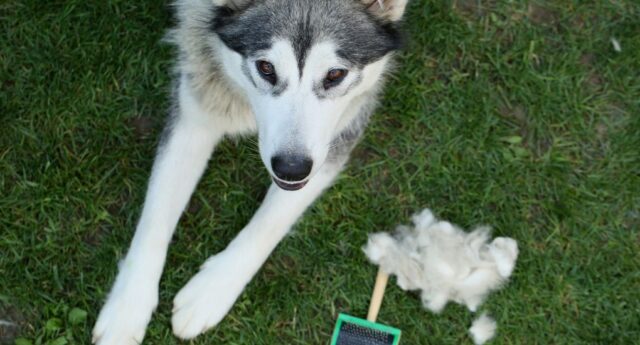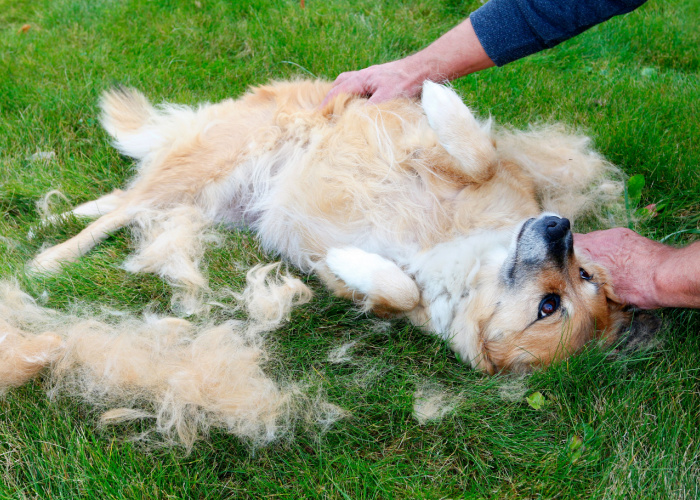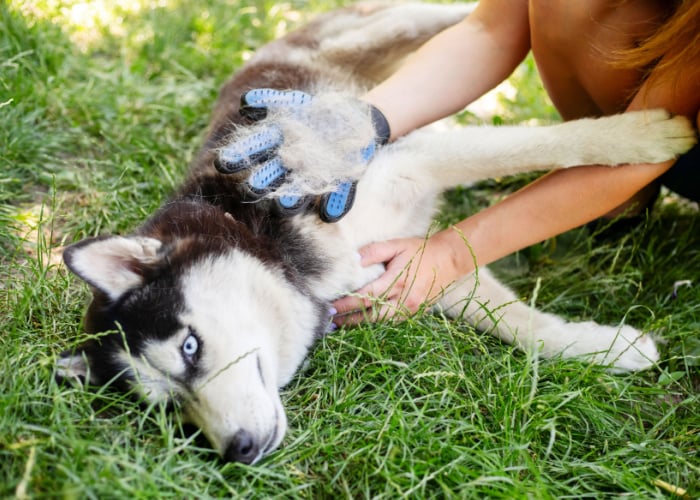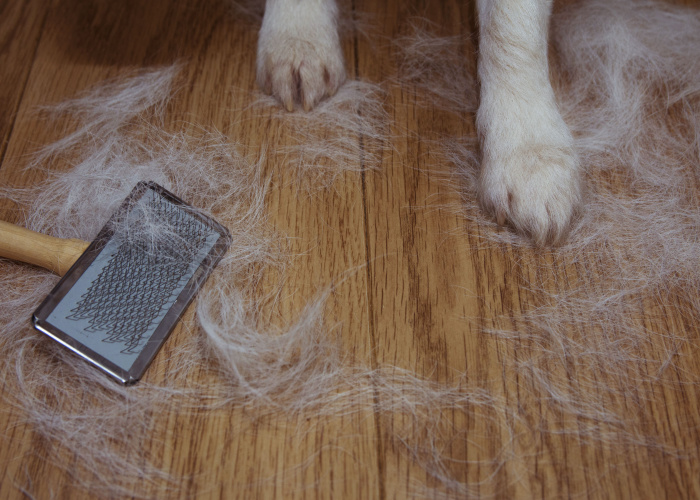
Table of Contents
Once summer arrives, it's time for dogs to shed their winter coats.
If you're a relatively new pet owner, you might notice that Fido is losing more fur during warmer temperatures.
So the question now is, do dogs shed more in the summer?
As temperatures rise, our dogs will need a little more extra care.
When summer arrives, we must provide easy access to water for them to cool off and hydrate.
We should also avoid walking when the heat is at its peak. Readjust your exercise schedules to a cooler time of day.
Another great way to cool off that your dogs will surely love is having icy popsicle treats.
However, do dogs' coats cool off in the summer too?
This blog will discuss everything you need to know about summer shedding in dogs.
And without further ado, let's get things started!

Do Dogs Shed More in the Summer?
Shedding is natural, and all dogs experience a specific level of shedding.
Some dogs shed more, others shed less, and others even shed constantly.
All dogs have fur that naturally sheds regularly due to the growth and regeneration of the hair.
When a dog is growing hair, it goes through a cycle. The phases of pet hair growth are:
- Anagen phase: Phase when new hair grows
- Catagen phase: Hair gets full length and stops growing.
- Telogen phase: Hair is neither growing nor being shed.
- Exogen phase: Hair starts to shed.
So the question still remains, do dogs shed more in the summer?
The truth is, shedding is common at the start of any season, whether it is summer, spring, or winter.
If summer is approaching, shedding is the dog's body's natural response to heat so that its fur gets lighter.
However, keep in mind that not all dogs have the same coats. Some dog breeds shed more in seasonal shedding.
Summer shedding happens as a result of the changes in temperatures.
During warm weather, dogs will throw away their winter coats to give way to a much lighter summer coat.
Then when it's time for winter, they will transition their coats to thicker, denser, and warmer coats.
Factors That Affect Dog Shedding
Shedding is a crucial part of a dog's skin and coat health.
Dogs must remove old, fragile, or damaged hair to stay comfortable and healthy.
There are a lot of factors that affect a dog's shedding.
Some of them are:
- Dog breed
- Age
- Hormones
- Health
- Diet
- Climate
- Type of coat (single-coated or double-coated)
The volume of fur will depend on what coat your dog is wearing. So does your dog have a single or double coat?

Single vs. Double Coat
One of the main factors that affect summer shedding is the type of hair your dog has.
Coat type can be grouped into two main categories: single and double.
Single-coated dogs only have one layer of fur. A few examples of dog breeds with single-coats are the Chihuahuas, Poodle, and Yorkshire Terriers.
On the other hand, double-coated pups have, of course, two layers, a top coat, and an undercoat.
Examples of dogs with double coats are the Labrador, Golden Retriever, and German Shepherd.
But other categories still take part in these two coat types.
For instance, a dog's fur can be long, short, smooth, curly, smooth, curly, and more.
Within those two coat types are many categories: long hair, short hair, smooth, curly, etc.
Dogs that have a heavy double coat will, of course, shed more heavily than others.
Their heavy shedding will last about 2-4 weeks during the spring and early summer.
On the other hand, dogs that have single-layer coats will shed less when the seasons change.
Even though summer shedding is normal and common for dogs, pet owners should still monitor their pets for excessive shedding since it can be linked to nutritional deficiencies and other health issues.

Tips for Dealing With Your Dog’s Summer Shedding
If you're struggling with summer shedding, we have you covered!
Below, we've compiled a list of tips on properly dealing with your dog's summer or seasonal shedding.
So if your dog is running around and leaving fur all over the house, you better scroll down!
Regular Brushing
Regular brushing is key to managing shedding in dogs and can help control matting.
Brushing is essential to dogs, especially heavy shedders.
If you don't brush your pup, excess fur can get trapped in the undercoat, forming knots and mats.
The lack of grooming can also lead to hair lumps that create friction on their skin which can cause infections or hot spots.
Even though every dog is unique, they require frequent brushing to keep their fur healthy and beautiful.
Moreover, brushing can help maintain cleanliness around the house.
Also, brushing can be your bonding time with dogs. I promise you that Fido will enjoy the attention.
Choose the right kind of brush
You'll need to find the right grooming tools to groom your pup effectively. Choosing the right dog brush will help make the grooming experience more enjoyable for both of you.
Using the wrong brush for your dog's coat type will still keep problems such as shedding and matting.
If you're struggling to choose the proper brush for your pup, here's a quick guide to help you out.
- De-shedder Brush: The de-shedder brush is best for reducing shedding and removing old or damaged fur. During shedding season, it's best advised to use it daily.
- Slicker Brush: For short-haired, long-haired, double-coated, hypoallergenic, wire-haired, and curly coats. Best for removing mats, dirt, and debris. It can also prevent knots and tangles and can even be used for massaging.
- Bristle Brush: for short-haired, long-haired, hypoallergenic, and curly coats. Best for removing dirt and debris on your dog's coat.
- Tick and Flea Brush: For all types of dog coats to remove ticks, fleas, and their eggs. It can also help remove these parasites in their larvae stage or when they are not easily visible to the naked eye.
- Pin Brush: Best for daily brushing, removing tiny knots and mats, freeing tangles, and massaging.
- Double-sided Brush: For short, long, double-coated, hypoallergenic, wire-haired, and curly coats. Great for removing mats, dirt, and debris. It can also prevent knots and tangles.
Use a Pet-Friendly Vacuum Cleaner

Fortunately, in this day and age, there are now vacuum cleaners that are specifically designed for homes with pets.
For instance, you can check out the Shark Navigator Professional Dog Hair Vacuum.
This vacuum features an innovative anti-allergen technology that can suck up almost all dirt and allergens.
If you have a family member who is allergic or sensitive to fur and other allergens, these vacuums are best for you.
Proper Diet
As a new pet owner, you should know that the dog's diet can also affect its coat.
That's why it's important to know the right diet and provide high-quality dog foods for their health and their coat's health.
If you're giving them the wrong type of diet and low-quality foods, their coat will be dull, broken, and you'll see plenty of dead hair and matting.
Protein is a must to maintain their coat's health.
You might also consider giving them Omega-3 fatty acids (DHA and EPA), which can help protect their skin.
Fatty acids, such as fish oils, can help their coat maintain health and shine by helping moisturize and prevent dry skin.
In addition, fatty acids can also work as an anti-inflammatory supplement, so that's a win-win for dogs suffering from inflamed skin and joints.
However, if you want to introduce a new diet to your dog, it's best advised to consult with a vet first.

Do Dogs Shed More in the Summer: FAQs
Why is my dog shedding so much all of a sudden?
Pet owners must be careful to determine whether their dog is seasonal shedding or excessive shedding.
Excessive shedding can be connected to low-quality dog food, wrong shampoo, parasites, stress, and other underlying health issues.
How often should I brush my dog?
Short-haired dogs should be brushed at least once a week.
On the other hand, daily brushing is recommended for medium, long-haired, and double-coated dogs.
How long does dog shedding last?
Expect your dog to shed heavily for about 2-4 weeks each season. However, it also depends on the breed or your dog's coat type.
If you've noticed that your dog is shedding an excessive amount of fur, watch out for skin irritations or changes in behavior and consult with your vet right away.
Do Dogs Shed More in the Summer? Before You Go…
“Here comes the sun, doo-doo-doo-doo”
Summer is finally here!
But have you noticed that your dog's hair has been scattered all over the house?
Now, you might wonder, do dogs shed more in the summer?
Well, yes. During summer shedding, dogs tend to lose their weak and old hair to transition from a much lighter one as a response to the heat.
This can be a problem for owners. Fur will be all over the sofa, bed, and other furniture.
Summer shedding in dogs occurs as a result of changes in temperatures.
When the warm weather comes, dogs need to throw away their winter coats to get ready for the summer.
The amount of shedding will be determined by many factors, such as the dog's coat type.
For instance, single-coated dogs like Dachshunds will shed less than double-coated dogs like Chow Chows.













